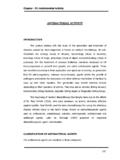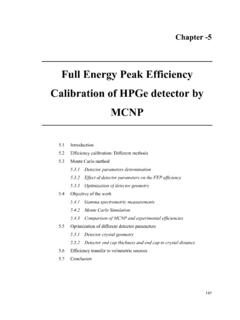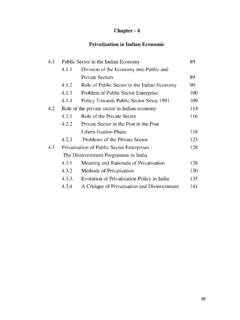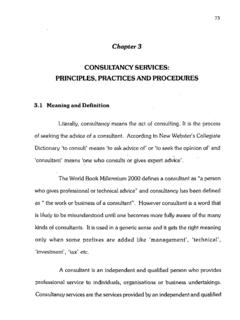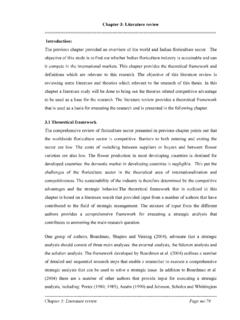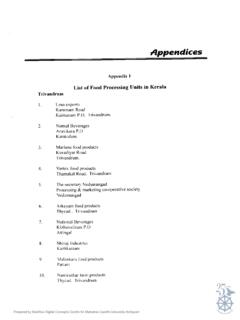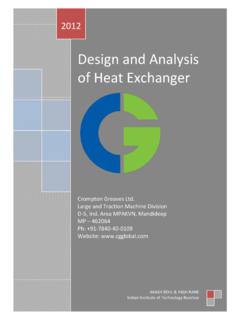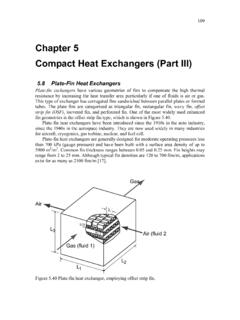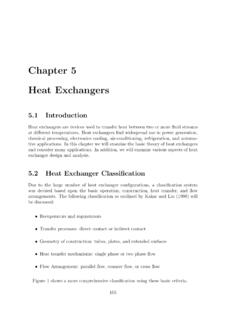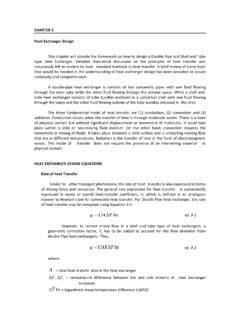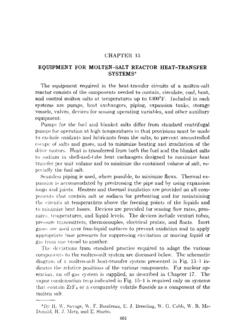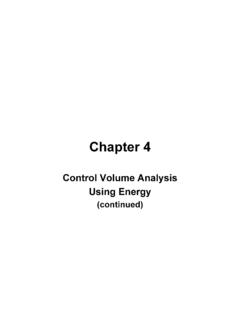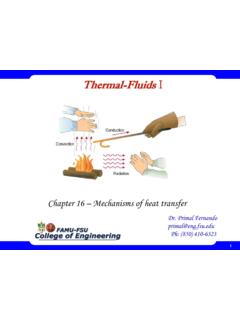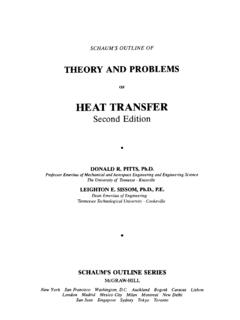Transcription of CHAPTER 4 THERMAL EFFECTIVENESS OF A SPIRAL PLATE …
1 55 CHAPTER 4 THERMAL EFFECTIVENESS OF A SPIRAL PLATE heat exchanger INTRODUCTION This CHAPTER discusses the study of THERMAL EFFECTIVENESS of the SPIRAL PLATE heat exchanger with liquid-liquid two-phase mixtures. THERMAL EFFECTIVENESS is a measure of heat transfer efficiency of the exchanger . It depends on the exchanger geometry, the properties of the hot and cold fluids used, and on the range of operating conditions. Quantifying THERMAL EFFECTIVENESS of a heat exchanger is critical in designing the exchanger for different applications. To determine the THERMAL EFFECTIVENESS of a heat exchanger , a geometric model of the exchanger has to be developed and a model of heat transfer in the exchanger has to be developed.
2 The model development that follows is that of Bes and Roetzel (1993), which has been used to study the THERMAL EFFECTIVENESS of the SPIRAL PLATE heat exchanger involving heat transfer to liquid-liquid mixtures. THERMAL EFFECTIVENESS THERMAL EFFECTIVENESS measures the efficiency of heat transfer in a heat exchanger . There are different definitions for the THERMAL EFFECTIVENESS , such as the - EFFECTIVENESS and the P- EFFECTIVENESS . Both are 56usually studied as a function of the mean number of transfer units (NTU). NTU measures the amount of heat to be transferred from the hot side to the cold side for unit temperature difference in the fluid.
3 Depending on the length of the heat exchanger needed to accomplish this temperature difference, the exchanger may be sized. The basic definition of THERMAL EFFECTIVENESS is the ratio of temperature difference accomplished in one of the sides to the maximum span that can be accomplished. Thus, for the hot side and the cold side, THERMAL EFFECTIVENESS is defined as: 1c1h1c2cc1c1h2h1hhTTTTP;TTTTP = = ( ) THERMAL EFFECTIVENESS is a function of NTU, heat capacity ratio, and the flow arrangement (curvature). Further, the flow patterns in two-phase flows can also significantly affect the THERMAL EFFECTIVENESS of the exchanger .
4 It is of interest to evaluate whether a purely THERMAL theory for a SPIRAL PLATE heat exchanger such as the ones derived by Bes and Roetzel (1993) and Martin (1992) is sufficient to reasonably capture the THERMAL performance of the exchanger . In this CHAPTER the THERMAL theory of Bes and Roetzel (1993) is presented first, and expressions are derived for the THERMAL EFFECTIVENESS of the hot side and cold side. Using the experimental data and the model equations, THERMAL EFFECTIVENESS for hot and cold sides are calculated and the trends analyzed. THERMAL EFFECTIVENESS is also calculated from the inlet and outlet temperatures using the definition provided in Equation The predictions of the model are compared against experimental data and the limitations of a purely THERMAL theory in predicting the performance of a SPIRAL PLATE heat exchanger with immiscible liquid mixtures are examined.
5 THERMAL THEORY OF A SPIRAL PLATE heat exchanger Bes and Roetzel (1993) have developed the THERMAL theory of SPIRAL PLATE heat exchangers wherein they have derived analytical expressions for the LMTD correction factor and the temperature EFFECTIVENESS (P) of the exchanger . In what follows, the derivation of Bes and Roetzel is presented. Direct mathematical manipulations are eschewed as the original source is accessible. Assumptions Involved The model applies only for the middle part of a SPIRAL PLATE heat exchanger , where heat is transferred to cold fluid from both walls.
6 Therefore the model works better for a SPIRAL heat exchanger with a large number of turns. In this study, the number of turns n = 60, large enough for end-effects to be neglected. Flow is assumed to be countercurrent, and a correction factor F is introduced for deviation from countercurrent flow. Flow is assumed to be steady. The exchanger geometry is assumed to be an Archimedean SPIRAL . This implies that the radius of the SPIRAL increases, continuously with the angle as: (),rbrmm+ = ( ) 58where b - PLATE spacing, rm - minimum radius, and m - angle at which the minimum radius is achieved. Therefore, temperatures may be expressed as a function of either radius or the angle.
7 Fluids are assumed to be completely mixed in the radial and axial directions within the flow channel. Thus in a cross-section chosen at a fixed angle, the temperature changes step by step from channel to channel. Hot fluid enters the exchanger in the centre of the apparatus and cold fluid flows in at the outermost channel. Overall heat transfer coefficient U is constant throughout the exchanger . There are no heat losses to the environment. Distance studs are not taken into account. THERMAL Theory In this model, the mean temperature difference between the fluids on both sides of a partition wall is tracked as a function of position in the exchanger .
8 To construct an Archimedean SPIRAL PLATE exchanger , a double slit is wound in a SPIRAL fashion. Therefore, each radius corresponds to two channels of rectangular cross sections. The inner SPIRAL is called the main SPIRAL , and hot fluid flows through it. The second SPIRAL (made from the outer slit) constitutes the side SPIRAL , and the cold fluid flows countercurrently through it. Thus, for each radius, two temperature differences may be defined, as shown for an elementary wedge in 59 Figure Both temperature differences are positive in the SPIRAL PLATE heat exchanger . Further, these differences of temperature depend upon each other; however, for convenience they will be separately derived as two different quantities and will later be combined with each other.
9 Figure Temperature differences in an elementary wedge of a SPIRAL PLATE heat exchanger Energy Balance Equations Let the heat capacity of the hot fluid be Ch. For the part of the channel between the radii r 1 and r, the hot fluid flows in the counter clockwise direction. Since is also measured counterclockwise, the flow direction of the hot fluid is the positive direction of . This hot fluid loses heat to the cold fluids in the channels between r 1 and r 2, and r and r + 1. Denoting the channel between r 1 and r as j, the above statement may be rewritten as: the hot fluid in j loses heat to the cold fluid in j 1 and j + 1.
10 Let the temperature of the hot fluid be denoted Th and that of the cold fluid be denoted TC. In order to indicate the temperature dependence on the 60position of the fluid in the exchanger , the temperature of the hot fluid in j is denoted as ())21(rTh , and that of the cold fluid in j + 1 is denoted as ())21(rTh+. Thus, the rate of change of heat transfer from the hot fluid in j to the cold fluid in j + 1 with respect to the angle is given by: + = =+21rT21rThrwThAqch1j,j ( ) Here the heat transfer area is given by A = (height of the exchanger ) (arc length of the curved channel). This arc length is given at a wedge by: =r1 Thus, the rate of change of heat transfer with respect to results in the above expression, as a first approximation.
